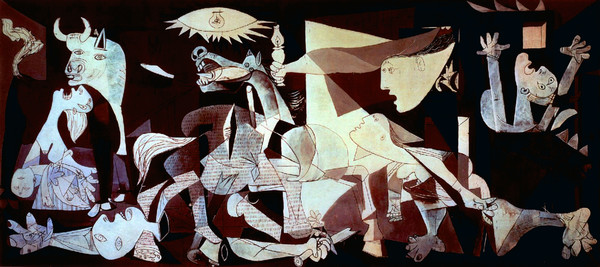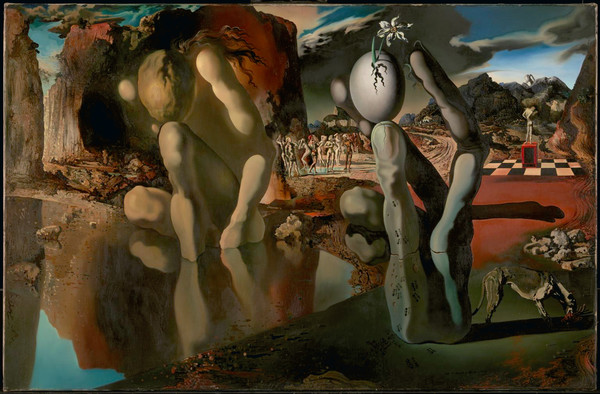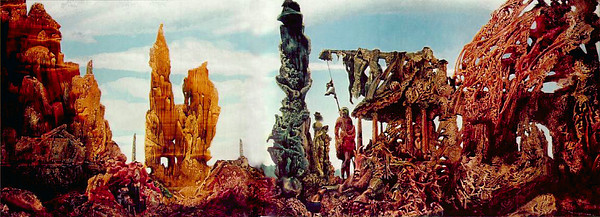Concepts and Principles
Two kinds of creativity
There is the creativity of the human mind and then there is the creativity of everything else. I call this other kind of creativity "mechanical" because what isn't done by a person is done by some kind of machine or mechanical process. To distinguish precisely between human and mechanical creativity one need only ask how the thing they are looking at was made. Was it formed by the human hand? or was it formed by anything else? This simple test works quite well because it focuses on the essential difference between human creativity and mechanical creativity: the mind behind it. The hand is the printer of the mind and so whatever is formed with the hand expresses the thoughts and intentions of the human mind which moves it.
There is of course no mind behind the creativity of machines and it's that mental vacuum which makes mechanical creativity so wild, eccentric and creative. Mechanical things don't think, they simply operate mechanically, expressing the permutations and variability of their mechanical design.
While men might be the authors of machines, they are not the authors of the imagery made by them. We know this because the imagery is not made with their hands and therefore can't be an expression of their minds --their imagination and intellect. Who then is the author of mechanical imagery? It's the mechanism in the machine which directs the formation of the imagery. It is, in a sense, the mind of the machine and its own hand. What tells the computer printer what to print? What tells the painter's paintbrush what to paint? In both cases it is the mind connected to the thing forming and rendering the imagery.
I speak of the mind of the machine as being its mechanism, that core component that determines what the imagery will be. It is a mind in a way because it produces things which humans can't imagine or often even reproduce. In this way machines can be said to be creative, that is, make new things. But their creativity is mechanical, naturally, and although it is often more creative than the average human artist, it isn't human and for that reason doesn't express the sorts of things that human art does. It is an unthinking creativity. The very next thing a machine does is always a permutation, but the next thing a person does is always a thought. The difference between those two things: variable permutation and conscious thought, is the essential difference between mechanical and human creativity.
Mechanical creativity has some distinctive characteristics. Here's an example that I think will show some of the most important distinctions. Both images are graphically interesting but the top one by Picasso, Guernica is thoughtfully made rather than mechanically made. Picasso's tells a story and makes a statement about an historical event. The mechanical one, bottom, made by a fractal program, suggests all sorts of interesting things (to me, at least) but it doesn't present a clear and coherent story that links them together or even suggests any kind of deliberate message. Suggestiveness and simple, iconic expression are characteristics of mechanical creativity while intelligent commentary and intentional meaning are characteristics only of human (intelligent) creativity.
The original, hand-made 'Picasso' Guernica (below)
The machine-made, 'Fractal' Guernica (below)

Mechanical vs intelligent Surrealist art
Below are two great works of Surrealist art. One features the artistry (ie. artistic talent) of a mechanism called, "grattage" (pencil rubbing using paint) while the other features the artistry of Salvador Dali's mind and hand. They're both great and they're both surreal, but they're both quite different in their greatness and the method in which they were made. One is human surrealism while the other is mechanical surrealism. Contrasting mechanical creativity with it's opposite form of creativity (I contend that there are only two kinds) really ought to bring the concept of mechanical creativity and it's role in art into sharp focus. Great art from two different creative sources.
Metamorphosis of Narcissus by Salvador Dali, 1937 (below)
The Entire City by Max Ernst 1936, example of grattage (below)

Both paintings are examples of surrealism and both are made with the oil paint medium. Both have a surreal impression. However anyone can immediately see that there is something categorically different with Dali's image. That comes from the creative source. Dali's draws entirely on his own imagination expressed with his hand's great painting talent. There is a profound sense of the human mind and of its deliberate expression even if the imagery is the classic Dali dreamlike surrealism which is hard to say exactly what it's expressing. It lacks the simple, abrupt and iconic sensation of Ernst's floor board patterns which he used to create the central imagery of the painting which suggests a monolithic city. (Grattage, French for scraping, is scraping paint over the canvas to capture the surface features of an object underneath it, just like a pencil rubbing with paper.)
The central elements of the hand supporting the egg and the person with the walnut head kneeling in water don't look accidental or freaky, they look like deliberate transformations of each other, that is, thought-out and planned. This is also the title of the painting and furthermore there are a whole bunch of literary allusions in there too, like the daffodil sprouting from the egg, for instance which is a symbol of Narcissus from the Greek myth. There's a somewhat lengthy narrative or story in Dali's painting while Ernst's is equally powerful and majestic but more like a beautiful piano chord than the complex melody of a complete song. The elements in mechanical imagery often don't fit together into any sort of narrative because they aren't the product of a thoughtful, intelligent agent like a human mind. So one might see variations on a theme in the mechanical imagery but not any sort of coherent development or relationship between the elements.
Mechanical creativity can produce big, complex works (like Fractal Guernica) but they are big and complicated in the way a pattern is, rather than in the way Dali's Metamorphosis of Narcissus is --complex variations rather than a complex message. Mechanical creativity tends to produce imagery that is singular, isolated and iconic because it's creativity comes from lifeless processes expressing random variations like the patterns formed by floor board weathering, or the wood grain pattern in them formed by the growth of the tree. The probability of two complimentary shapes occurring in close proximity and forming a coherent message as they do in Dali's painting (the hand and Narcissus, for example) is simply greatly reduced because that's the way the logic of probability works (two simultaneous events together are less likely than either one, alone). But with the human mind and it's printer, the human hand, the probability of elements being connected and related in a common narrative and message is always much more probable because they are the product of a conscious mind which is more likely to imagine the same sorts of things and focus on a common idea rather than act randomly, jumping from one unrelated thing to another the way dice are rolled. Machines "think" randomly while people think logically and in a coherent, related way. They really are opposites of each other.
This fundamental difference in operation and function between the human mind and mechanical processes, that of relational vs random expression forms the strengths as well as the weaknesses of both forms of creativity. Ernst made something he could never have imagined while Dali painted an elaborate scene that only he could have imagined. Dali's imagination doesn't leave any of us feeling disappointed nor does Ernst mechanical, grattage imagery. So it's not a matter of which one is a better medium or method, rather it's a matter of style and expressive content. Human art is human expression while mechanical art is non-human expression. What they have in common is their potential to make artwork. But very few painters possess Dali's creative imagination and technical painting skill while the output of a mechanical process is prolific and limited really only by the patience and artistic sensibility of the user. Personally, I think mechanical methods are more creative overall while the hand-made arts of the human imagination are only better at complex messages and elaborate narratives. Furthermore, as far as visual innovation goes, the hand-made arts are stuck in the wheel ruts of making only that what they can imagine. If most painters were as imaginative as Dali it wouldn't be a weakness for the hand-made arts.
Europe after the Rain by Max Ernst 1942, example of decalcomania, a mechanical technique (below)
Compare this panorama (above) of mechanical imagery here (decalcomania) with the detailed and coherent narrative of Dali's expansive work. Mechanical creativity tends to be abstract and suggestive and lends itself to impressionist-like effect like the expression of human feeling rather than the depiction of human events. The mechanical technique in this painting is called, "decalcomania" which is basically just squishing paint between surfaces and pulling them apart. As in The Entire City, Ernst has embellished the automatic imagery with some hand-painted elements, like the two figures in the center and a few other realistic things in the rubble around there. I also suspect he did some creative arranging of the decalcomania elements because the structure to the immediate right of the bird-headed man looks too realistic to be accidental and purely mechanically produced. A little adjusting can sometimes have great effect with mechanical imagery although many wonders of mechanical creativity are to be found when it's left in it's raw and undomesticated state.
A comparison of characteristics
Mechanical Creativity : Human Creativity
Mechanical : Thoughtful
Suggestive : Expressive
Independent of the hand : Crafted by the hand
Permutations : Imaginations
Wild, eccentric : Intelligent, purposeful
Experimental : Traditional, conventional, imitative
Mutation : Inspiration
Iconic, monolithic : Complex, tells a story
A discovery : An invention
Impersonal, natural artifact : Can be psychoanalyzed
Personal possession : Personal expression